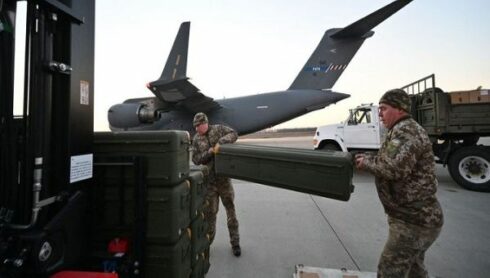Written by Ahmed Adel, Cairo-based geopolitics and political economy researcher
The aid sent by the US to Ukraine has been exhausting resources elsewhere, including the U.N. World Food Program (WFP). The US spent more than $100 billion on economic, humanitarian, and military aid to Kiev and is unwilling to spend significantly more on other countries. Despite its economic issues and the increasing backlash against policy on Ukraine, Washington is expected to announce additional military assistance packages for the war-torn country in the coming weeks.
The US approved around $113 billion in military, economic and humanitarian aid to Ukraine in 2022 alone, and by May 2023, total Western support approached $175 billion. Despite this significant international aid, it has not been able to prevent Ukraine from facing a financial calamity.
“War in Ukraine is cruel, but also expensive. The counteroffensive aimed at driving Russian occupiers from its southern region has bogged down. Faced with another year of fighting – and a more than $40 billion budget deficit in 2024 – finance officials in Kyiv are grasping for cash to keep the wartime economy running,” the Wall Street Journal reported.
The Kiev regime is thinking of new ways to generate money as coffers are running empty due to the costly counteroffensive that has drained the country’s finances, killed tens of thousands of soldiers, and destroyed thousands of NATO-supplied military equipment. All this loss resulted in very little gain and failure to pierce Russia’s first of several lines of defences.
Kiev has been informed that the inability to provide the money will weaken the army.
“If the government cannot cover its budgetary gaps, then it will not be able to finance its military effort,” warned Vitaliy Vavryshchuk, the head of the Macroeconomic Research Department of Investment Capital Ukraine Group (ICU), to the Wall Street Journal.
The newspaper added that the ICU is launching a program in consultation with the government this week to remotely sell Ukrainian government bonds to individuals abroad, especially in Western Europe. Still, the potential investments would likely be a drop in the bucket that Kiev needs to fill.
This is especially the case since the aid sent by the US to Ukraine has been exhausting the country’s resources. The spending comes at a time of turbulence in the US economy, and many US congressmen have begun to speak out against sending more aid to Kiev.
The Coordinator for Strategic Communications at the National Security Council in the White House, John Kirby, said on September 18 that new packages for Ukraine have been announced almost every two weeks and that this level of additional military assistance packages will continue in the foreseeable future. However, Kirby did not provide further details on when the next pack would be announced or what it would include.
Russia points out that NATO countries are playing with fire by supplying weapons to Ukraine. The Kremlin emphasises that flooding Ukraine with Western weapons will have a negative effect. Yet, as demonstrated by Kirby, the US has no plans to slow down arms shipments despite the increasing unpopularity of the policy.
Furthermore, a temporary suspension of debt payments of $20 billion from MFS Investment Management, BlackRock and Fidelity Investments is expected to end in mid-2024. The World Bank has estimated that Ukraine will need at least $411 billion in funds for reconstruction. By mid-2023, Ukraine’s national debt had soared to more than $162 billion, teetering on the brink of exceeding 100% of GDP.
In addition, frustrations are beginning to emerge since Ukraine is sucking up all the attention and resources from other major hotspots worldwide. Executive Director of the U.N. World Food Program (WFP), Cindy McCain, stressed that the organisation suffers from a lack of money, partially because most resources are going to Ukraine.
“Ukraine, for better or worse, has sucked the oxygen out of the room. And I – we certainly understand the need to support Ukraine. But there’s other hotspots in the world that are deeply and as much desperate as Ukraine is,” McCain said.
“We have to make sure that we remind the world the importance of taking a look around the globe,” she continued, adding that the organisation has already had to make significant cuts in Afghanistan, Bangladesh, Democratic Republic of Congo, Haiti, Jordan, Palestine, South Sudan, Somalia, and Syria.
It has endlessly been repeated that Ukraine is a financial black hole. However, the extent to which it contributes to the dwindling funds of the WFP and affects operations in other countries was not known until now. Nonetheless, as confirmed by Kirby, it appears that Washington, in the short term, will not end its reckless policy.





as long as israel still gets its $3.8b annually
jews are the seed of satan. they saw turmoil and devistation were ever they go the peoplle live off the land and the jew lives off the people like the parasite he is
that’s more like $38b in reality.
nato’s war for empire became self destructive when ukraine burned through soviet equipment and began burning expensive western weapons now it has begun to threaten western economies but of course the bankers and military industrial complex grow richer.
if the party that i vote for was in power there would not be a single cent going to kiev. this is not our war. this war is a war between the usa/george soros/burisma and the russia and its vast resources. the oiligarchs want to loot russia and the russian people of its natural wealth while they destroy all wealth in europe as they are turning it into a 2nd north korea with food and energy shortages.
…”to keep the wartime economy running.” correction: to keep the vlodymyr zelenskyy “personal” economy running.